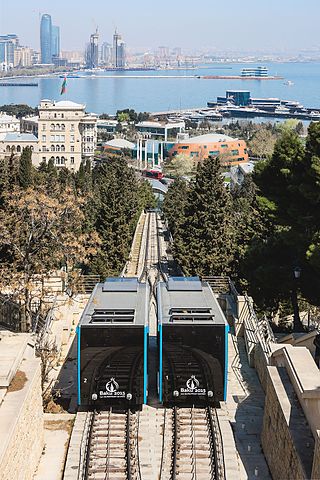
A funicular is a type of cable railway system that connects points along a railway track laid on a steep slope. The system is characterized by two counterbalanced carriages permanently attached to opposite ends of a haulage cable, which is looped over a pulley at the upper end of the track. The result of such a configuration is that the two carriages move synchronously: as one ascends, the other descends at an equal speed. This feature distinguishes funiculars from inclined elevators, which have a single car that is hauled uphill.
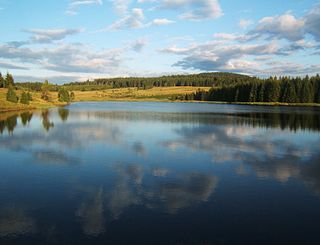
The Ore Mountains lie along the Czech–German border, separating the historical regions of Bohemia in the Czech Republic and Saxony in Germany. The highest peaks are the Klínovec in the Czech Republic at 1,244 metres (4,081 ft) above sea level and the Fichtelberg in Germany at 1,215 metres (3,986 ft).
This is a list of the extreme points of Europe: the geographical points that are higher or farther north, south, east or west than any other location in Europe. Some of these positions are open to debate, as the definition of Europe is diverse.

The Dresden Suspension Railway is a suspended funicular located in Dresden, Germany, and connects the districts of Loschwitz and Oberloschwitz. It is one of the oldest suspension railways, having entered service on 6 May 1901, the same year the Wuppertal Schwebebahn entered service. Like the Wuppertal railway, this system was designed by Eugen Langen. The line is 274 metres (899 ft) long and is supported on 33 pillars.

The Wuppertaler Schwebebahn is a suspension railway in Wuppertal, Germany.

The Singapore Cable Car is a gondola lift providing an aerial link from Mount Faber on the main island of Singapore to the resort island of Sentosa across the Keppel Harbour.

The Klein Matterhorn is a peak of the Pennine Alps, overlooking Zermatt in the Swiss canton of Valais. At 3,883 metres (12,740 ft) above sea level, it is the highest place in Europe that can be reached by aerial tramway or gondola lift, as well as by any other means of transport. The Klein Matterhorn is part of the Breithorn massif and overlooks on its south side the almost equally high flat glacier named Breithorn Plateau, just north of the international border with Italy. The name "Klein Matterhorn" is a reference to its much larger neighbour, the Matterhorn, which lies 7 km (4.3 mi) away across the Theodul Pass.

The H-Bahn in Dortmund and Düsseldorf is a driverless passenger suspension railway system. The system was developed by Siemens, who call the project SIPEM.

The Fichtelberg is a mountain with two main peaks in the middle of the Ore Mountains in the east German state of Saxony, near the Czech border. At 1,214.6 m (3,985 ft) above sea level, the Fichtelberg is the highest mountain in Saxony, the second highest in the Ore Mountains and used to be the highest mountain in East Germany. Its subpeak is 1,206 m (3,957 ft) high.

The Seilbahn Zugspitze is an aerial tramway running from the Eibsee Lake to the top of Zugspitze in Bavaria, Germany. It currently holds the world record for the longest freespan in a cable car at 3,213 metres (10,541 ft) as well as the tallest lattice steel aerial tramway support tower in the world at 127 metres (417 ft). Construction of the system began in 2015 and it opened on 22 December 2017.

The Glacial Aerial Tramway Kaprun III is the third section of the aerial tramway on the Kitzsteinhorn mountain at Kaprun, Austria. It was placed in service on 26 November 1966. It is currently branded Gipfelbahn.
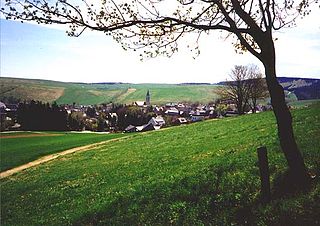
Oberwiesenthal is a town and a ski resort in the district of Erzgebirgskreis in Saxony in Germany. It is situated in the Ore Mountains, on the border with the Czech Republic, 19 km south of Annaberg-Buchholz, and 23 km northeast of Karlovy Vary. At 914 metres (2,999 ft), it is the highest town in Germany. The Olympic and World Championships goldmedalist in ski jumping Jens Weißflog competed for SC Tractor Oberwiesenthal and Oberwiesenthaler SV.
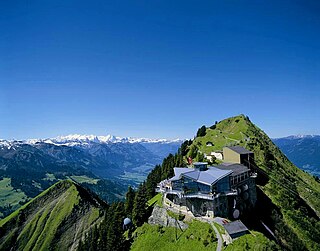
The Stanserhorn is a mountain in Switzerland, located in the canton of Nidwalden near to the border with Obwalden, with the peak at 1,898 metres (6,227 ft) above sea level.
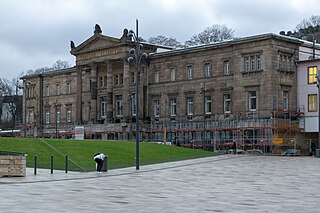
Wuppertal Hauptbahnhof is a railway station in the city of Wuppertal, just south of the Ruhr Area, in the German state of North Rhine-Westphalia. It is on the line between Düsseldorf/Cologne and Dortmund. The 1848 reception building is one of the oldest of its kind. The station was originally Elberfeld station and has been renamed several times since. Since 1992, it has been called Wuppertal Hauptbahnhof. Wuppertal Hauptbahnhof is also the site of lost luggage operations for Deutsche Bahn.

The Langkawi Cable Car, also known as Langkawi SkyCab, is a gondola lift and one of the major attractions in Langkawi Island, Kedah, Malaysia. It provides an aerial link from the Oriental Village at Teluk Burau to the peak of Gunung Machinchang, which is also the location of the Langkawi Sky Bridge. The total length is 2.2 km (1.4 mi), with a journey time from the base to the top of around 15 minutes. It was officially opened in 2003.

The Tyrolean Zugspitze Cable Car was the first wire ropeway to open the summit of the Zugspitze, Germany's highest mountain on the border of Austria. Designed and built by Adolf Bleichert & Co. of Leipzig, Germany, the system was a record-holder for the highest altitude.
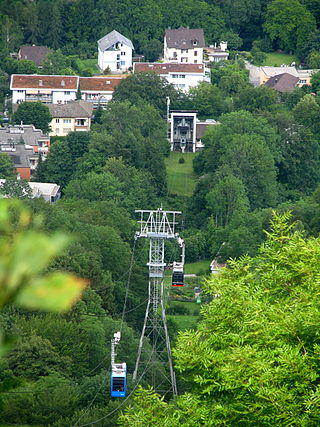
The Adliswil-Felsenegg cable car is a cable car in the canton of Zürich in Switzerland. The lower station is located in Adliswil in the Sihl Valley, whilst the upper station is located on the Felsenegg hill on the Albis ridge near the Felsenegg-Girstel TV-tower. The upper station at Felsenegg forms one end of a panoramic walk to the Uetliberg mountain, whilst the lower station is some 400 metres (1,300 ft) from Adliswil railway station.

The Ochsenkopf is the second-highest mountain in the Fichtel Mountains with a height of 1,024 metres (3,360 ft). On its summit is an observation tower and a transmission tower for VHF and TV programmes by Bayerischer Rundfunk.

The Fellhorn Lift is a two-section gondola lift in the German Alps that runs from Birgsautal in Oberstdorf to the peak of the Fellhorn – 1,967 metres above sea level (NN).

Teide Cableway is an aerial tramway that goes up Mount Teide, the highest peak in Spain, located in Teide National Park in Tenerife, Canary Islands. Starting at the base station at 2,356 metres (7,730 ft) above sea level, it ascends to the top station at 3,555 m (11,663 ft) in eight minutes, at a maximum speed of 8 m/s (26 ft/s) and carrying 44 people per cabin. Conceived in 1929, construction of the cableway started on 5 September 1963 and was completed on 27 July 1971, starting operations on 2 August 1971. It was renovated between 1999 and 2007.




















